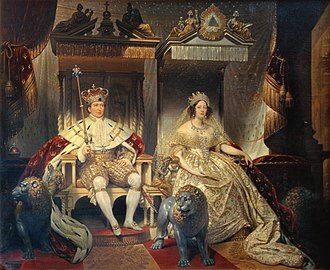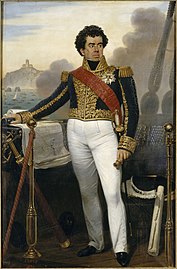| This article includes a list of general references, but it lacks sufficient corresponding inline citations. Please help to improve this article by introducing more precise citations. (January 2021) (Learn how and when to remove this message) |
Joseph-Désiré Court (14 September 1797, Rouen – 23 January 1865, Paris) was a French painter of historical subjects and portraits.
Life and work
He was a descendant of the portrait painter Hyacinthe Rigaud and displayed an early interest in art. His first studies were with Marc-Antoine Descamps [fr], at a drawing school established by Descamps' father, Jean-Baptiste. Following that, he worked at the studios of Antoine-Jean Gros in Paris.
His allowance from his family was not quite enough for his needs, so he painted small pictures, which he sold through an agent. Despite this, he was unable to save enough money to continue his studies in Rome. Hoping that he could go at the expense of the state, he competed for the Prix de Rome and, in 1821, was awarded a prize for his depiction of Samson and Delilah. During his stay there, he continued to send works back to Paris for exhibition. His painting, "The Death of Caesar", was acquired by the Musée du Luxembourg in 1827.
In 1828, the Académie de Rouen named him a corresponding member, and commissioned a large painting for their new meeting room. Although their request was for an easel painting only, he produced a monumental canvas depicting the playwright Corneille, receiving honors from the nobility after the premiere of his tragedy, Cinna. Court was presented with a gold medal in gratitude.
Following the July Revolution, the government of King Louis-Philippe held a competition for a large canvas, to adorn the new room at the Chamber of Deputies. Three topics were offered. Court chose to paint Mirabeau facing Dreux-Brézé at the Estates General of 1789. His sketch came in second. Dissatisfied with the jury's decision, he executed the painting anyway; exhibiting it at the Salon in 1833. It may now be seen at the Musée des Beaux-Arts de Rouen. He did eventually receive some major public commissions, including figures for the Hôtel de Ville (1841), and paintings for the dome of Saint Isaac's Cathedral (1850). Much of his work was, however, devoted to portraiture.
He had long wanted to return to his hometown so, in 1853, he accepted an appointment as Conservator at the Musée de Rouen; immediately beginning a project to renovate the museum's rooms.
He succumbed to an unspecified chronic illness while in Paris receiving treatment. His remains were taken home and interred at the Rouen Monumental Cemetery. He had been the recipient of numerous honors, including the Legion of Honor in 1838.
Gallery
-
 Rigolette keeping herself busy while Germain is away. 1842
Rigolette keeping herself busy while Germain is away. 1842
-
 Portrait of Yekaterina Alekseevna Vasilchikova (Scherbatova), 1840s
Portrait of Yekaterina Alekseevna Vasilchikova (Scherbatova), 1840s
-
 Portrait of Olga Alekseevna Golitsyna (Scherbatova), 1840s
Portrait of Olga Alekseevna Golitsyna (Scherbatova), 1840s
-
 King Christian VIII and Queen Amalie in Their Coronation Robes
King Christian VIII and Queen Amalie in Their Coronation Robes
-
 Guy-Victor Duperré. 1832
Guy-Victor Duperré. 1832
-
 The King gives the flags to the National Guard of Paris and the Banlieu
The King gives the flags to the National Guard of Paris and the Banlieu
(29 August 1830). 1834 -
 Sylvain Charles Valée. 1838
Sylvain Charles Valée. 1838
-
 Nymph and Faun bathing, 1824
Nymph and Faun bathing, 1824
-
 The Death of Caesar, 1827
The Death of Caesar, 1827
-
 Prince Peter of Oldenburg in the Preobrazhensky Life-Guard Regiment, 1842
Prince Peter of Oldenburg in the Preobrazhensky Life-Guard Regiment, 1842
References
- Documentation @ the Base Léonore
 This article incorporates text from a publication now in the public domain: Bryan, Michael (1886). "Court, Joseph Désiré". In Graves, Robert Edmund (ed.). Bryan's Dictionary of Painters and Engravers (A–K). Vol. I (3rd ed.). London: George Bell & Sons.
This article incorporates text from a publication now in the public domain: Bryan, Michael (1886). "Court, Joseph Désiré". In Graves, Robert Edmund (ed.). Bryan's Dictionary of Painters and Engravers (A–K). Vol. I (3rd ed.). London: George Bell & Sons.
Further reading
- Adolphe Decorde, Précis analytique des travaux de l’Académie des Sciences, Belles-lettres et Arts de Rouen, Rouen, H. Boissel, p. 140-7 ISBN 978-0-270-20838-2
External links
- « Joseph-Désiré Court » @ the Réunion des musées nationaux et du Grand Palais des Champs-Élysées.
- « Joseph-Désiré Court » @ the Base Joconde.